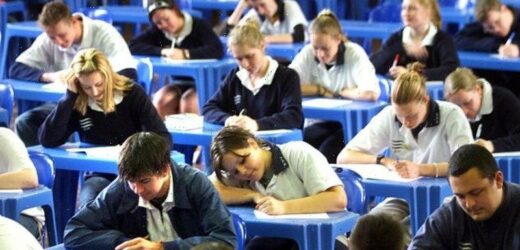The literacy and numeracy skills of every Victorian year 12 student will be tested and recorded on their graduating certificate this year for the first time, giving employers better insights into young jobseekers’ basic capabilities in reading and maths.
The assessment will form part of a revamped General Achievement Test, significantly raising the stakes of a test that until now has mostly had little to no bearing on a student’s post-school life.
About 90,000 VCE and VCAL students will have their literacy and numeracy skills assessed in a revamped General Achievement Test this year.Credit:Jason South
In another first, the test commonly known as the GAT will also be taken by tens of thousands of senior secondary students completing the Victorian Certificate of Applied Learning, and thousands completing an unscored VCE.
They will receive a certificate of attainment stating they either met or exceeded minimum standards of literacy and numeracy. Students who do not meet the standards in the new test will not receive a certificate but will still graduate as long as they pass their year 12 subjects.
The literacy and numeracy standards will not affect a student’s ATAR, the tertiary admission ranking used for university entrance.
Victoria is the only state that does not explicitly include literacy and numeracy standards as part of its senior secondary reporting.
Industry and applied learning groups welcomed the reform, saying it would give employers better clarity about graduates’ capabilities, but they also warned the new assessment could increase anxiety among students who struggle with exams.
The revamped test, which is generally held in June, will be held on September 7 this year. About 90,000 students – a record number – will sit it.
The three-hour test will be split into two parts: section A will assess literacy and numeracy skills and will be taken by VCE and VCAL students; section B will assess skills in English, maths, science, technology, the arts and humanities, plus critical and creative thinking. It will be taken by VCE students.
Students are not expected to study for the GAT, which is used as a yardstick for students’ exam results and school-based assessments. GAT results also come into play as insurance for students who miss an exam or exams and must receive a derived examination score.
Education Minister James Merlino said it was vital for Victorian school-leavers to demonstrate basic literacy and numeracy skills, making sure they are ready for further education or to join the workforce.
“We heard from employers that they wanted simple and clear indicators on the job-readiness of young people, building on our changes to the VCE system that will give students the academic and vocational skills they need,” he said.
The change will come one year before Victoria’s planned transition to a new integrated senior secondary certificate, which will merge VCE and VCAL into one certificate.
Helene Rooks, chief executive of the Victorian Applied Learning Association, said it was important to give VCAL students an opportunity to sit a standardised test – something the current version of the certificate does not include.
“While VCAL students are not doing standardised tests, they will come across them in their lives. You need to do a literacy and numeracy test to enter a TAFE course, so it’s good that students have the opportunity to be exposed to doing this test,” she said.
But she added it was likely the new standards would increase anxiety in students who selected a VCAL pathway, because it does not involve exams.
Adam Voigt, a former principal who is chief executive of consultancy Real Schools, cautioned that raising the stakes with the GAT could backfire, placing undue pressure on students to perform, particularly those who experience anxiety about being ranked against their peers.
“We have a little obsession in Australia with attaching high stakes to point-in-time tests,” he said. “The GAT doesn’t tell you everything in the same way that NAPLAN doesn’t tell you everything. We read way too much into it, in terms of how students are going to perform at the end of the year, and that drives certain kids out of education when we want them to stay.”
Megan Lilly, the Australian Industry Group’s executive director of education and training, said poor literacy and numeracy skills among new employees and apprentices were “a real issue in the workplace”.
She said employers in Victoria had been calling for more reliable information on school-leavers’ fundamental skills.
“From year 12, from the senior levels of schooling, it is hard to get a gauge on their literacy and numeracy levels,” she said. “You can get a gauge on success or levels of achievement in particular subjects they’ve done, but not their literacy and numeracy levels, and yet they are such fundamentally important underpinning skills.”
Victorian Curriculum and Assessment Authority chief Stephen Gniel said students’ literacy and numeracy skills are developed and assessed over the course of their education and the revamped GAT “will provide an additional measure of literacy and numeracy skills as students complete their senior school education”.
The Morning Edition newsletter is our guide to the day’s most important and interesting stories, analysis and insights. Sign up here.
Most Viewed in National
From our partners
Source: Read Full Article


